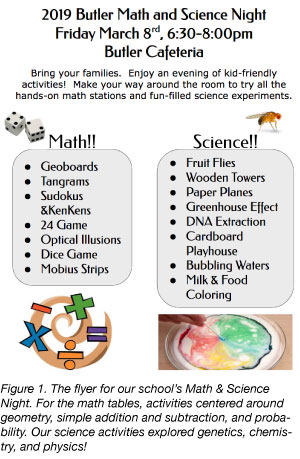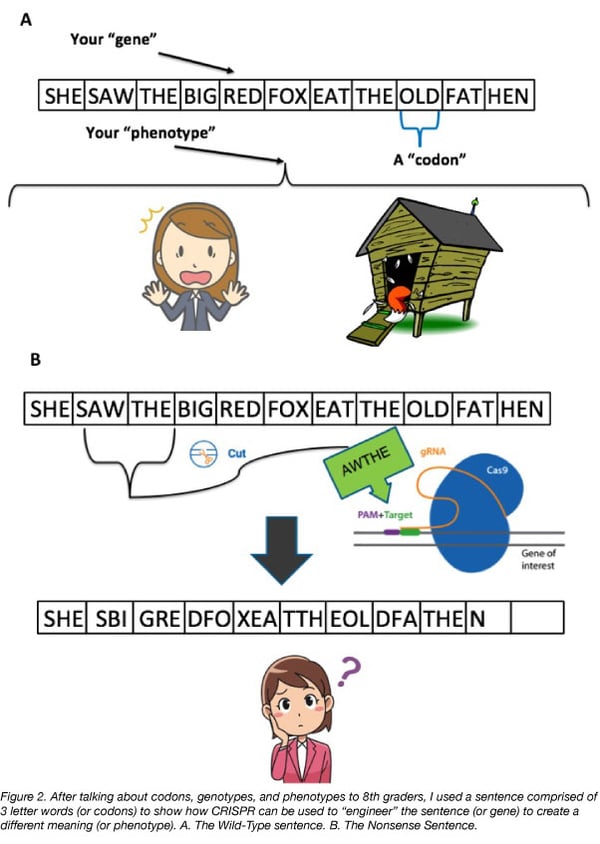As a person with many roles and responsibilities, I have to think a lot about how to balance those roles. I’m a father of three, a scientist and science communicator, and I strive to be a volunteer and contribute to my community. This past year, I spent some time thinking about how I could combine all of these roles by reaching out to my school district not just as a dad, but as a scientist.
When our elementary school needed a new coordinator for the annual Math & Science Night, I took the reigns. I also volunteered when our middle school’s 8th grade science teachers reached out to their students’ STEM-oriented parents looking for experts to come give guest presentations. If you’re a scientist thinking about reaching out to your community’s schools, here are a few tips and lessons I’ve picked up from my recent experiences.
STEM in elementary schools - catching them early
 I’m fortunate to live in a town with a good public school system that has made strong efforts in the last 5 years to incorporate more science and technology into the school curriculum. Our Parent Teacher Association (PTA) has been instrumental in supplementing that curriculum. It’s through the PTA that I recently started coordinating the annual Math & Science Night, a chance for parents and other members of the community to share their expertise with the kids through some fun activities. If your school doesn’t have a Math & Science Night (or some equivalent), here are some quick tips to get things going:
I’m fortunate to live in a town with a good public school system that has made strong efforts in the last 5 years to incorporate more science and technology into the school curriculum. Our Parent Teacher Association (PTA) has been instrumental in supplementing that curriculum. It’s through the PTA that I recently started coordinating the annual Math & Science Night, a chance for parents and other members of the community to share their expertise with the kids through some fun activities. If your school doesn’t have a Math & Science Night (or some equivalent), here are some quick tips to get things going:
- If your PTA has a general meeting and a means to request funding for events, consider reaching out to it. PTAs have more flexibility than the school district itself in terms of what they do with their discretionary money. They also usually have a good event-planning base and will know how to reserve space, time events, and network for volunteers.
- Speaking of volunteers, you can’t run an event like this without them! If you live in a school district that has a lot of parents in STEM careers, chances are they’re wondering how they could contribute to the school, too. Though you can recruit parents from any background, it really helps if activities are run by parents who can answer some of the surprisingly technical questions elementary students can ask. It doesn’t just need to be people who think of themselves as “scientists.” We had some accountants running our math tables!
- Be realistic about what you can teach 5-10 year olds in a single evening. Grades K-5 cover a broad range of attention spans, skill levels, and STEM exposure. If you expect a lot of kids, you’re going to want a lot of activities (try for a dozen!). The best approach may not be “let’s try to make this STEM activity fun,” but rather “let’s see how we can make this fun activity relate to STEM.” Figure 1 shows the activities we had for my school’s Math & Science Night.
- There are plenty of places to get ideas for science activities. I did some crowdsourcing on Twitter and got lots of suggestions. Here are just a few resources:
- Biology and Chemistry activities from Quatr.us
- Foldscopes
- Steve Spangler Science
- The Fab Lab
Middle school: supplementing the science curriculum
Sharing my expertise with our district middle school was a very different experience since, unlike elementary schools, middle schools have dedicated science teachers. I tried contacting our school district’s science curriculum coordinator with minimal luck, but eventually the 8th grade science teachers at our school put out the call to local parents who would feel comfortable speaking on topics that would compliment the STEM curriculum. As it happened, I’d met some of the 8th grade science teachers socially and we’d already discussed the idea of my giving a CRISPR presentation to their students. I didn’t think of this opportunity as coming from networking at the time, but that means it was the best kind of networking!
Since nearly every talk I’ve given in the past 20 years has been aimed at grad students, postdocs, and other working scientists, creating a presentation for 8th graders was a little intimidating. Too simplistic and I would insult the students. Too complicated and I would quickly lose their interest. I won’t claim that I blew their minds, but I think many of the students learned something. Based on the initial guidelines I received from the teachers, I formulated the presentation as follows (which could be adapted for any topic--not just CRISPR):
- Who am I? Where do I work? The teachers emphasized that some students would be curious to hear what a scientist does, and how one becomes a scientist. I gave a timeline of my science life, starting back to Mr. Kelley, my 7th grade biology teacher. I led up to my job at Addgene, which is likely a career path none of them had imagined for a scientist. I think that establishing this history helped demonstrate that a) I was a real person who used to be a middle schooler himself and b) I had the background to be considered an authority in this area.
- What is genome engineering? How does CRISPR work? This section was essentially background slides getting everyone on the same page in terms of the vocabulary--DNA, protein, plasmid, gene, etc. Though I talked about CRISPR’s molecular mechanism, I was careful to keep it relatively simple. I honed the complexity of the talk by running it by the teachers and sharing some slides on Twitter, where I was able to get some great feedback from teachers and other science communicators.
- What can CRISPR do? I spent more time on this section of the presentation because, in my opinion, it was more important to communicate the applications of CRISPR over the details of how it worked. I came up with an analogy that would help them grasp some of the key concepts (Fig. 2). One thing I will likely change for next time is giving fewer examples and think of a way to make this section more interactive. If you can think of a good analogy that involves student participation, make it happen!
- How should we use CRISPR? How shouldn’t we use it? This last section was arguably the most important, and it was a little worrisome for me since bioethics is an inherently subjective area. For CRISPR, I focused on the fact that, like computers and the internet before it, genome engineering technology is moving along much faster than it can be officially regulated. I did not try to sugarcoat the potential dangers of people using the technology in an unethical manner, but I also tried not to be an alarmist.
 The overarching guideline for all of these questions, and for any topic you might present to middle schoolers, is to provide current examples. When I asked Joanne Marks, one of the 8th grade science teachers with whom I worked, for feedback on my presentation, she said “it was such a valuable extension to our curriculum and offered engaging examples of how understanding genetics is so timely.” Genome engineering, and many other technologies and fields in biology, are moving so quickly that it’s basically impossible for textbooks to keep up. Even the most ambitious teachers, who work hard maintaining a current, dynamic curriculum, would be hard-pressed to maintain the pace of CRISPR. Two of the examples I used in my presentation had only become public in the previous two weeks, which demonstrated to the students that scientific history was very much in the making.
The overarching guideline for all of these questions, and for any topic you might present to middle schoolers, is to provide current examples. When I asked Joanne Marks, one of the 8th grade science teachers with whom I worked, for feedback on my presentation, she said “it was such a valuable extension to our curriculum and offered engaging examples of how understanding genetics is so timely.” Genome engineering, and many other technologies and fields in biology, are moving so quickly that it’s basically impossible for textbooks to keep up. Even the most ambitious teachers, who work hard maintaining a current, dynamic curriculum, would be hard-pressed to maintain the pace of CRISPR. Two of the examples I used in my presentation had only become public in the previous two weeks, which demonstrated to the students that scientific history was very much in the making.
One of the exciting, and challenging, aspects of talking to 8th graders was the broad range of questions I received. I gave my presentation five times to groups of about 50 students each, and each group went on its own wonderful tangents. Some groups asked about vaccines, others were curious about the agricultural repercussions. Was every student riveted? Absolutely not. But seeing some students really get it, and trying to answer some of their great questions, was immensely gratifying. I came out of the experience with a renewed appreciation of our science teachers’ difficult-but-rewarding jobs, and an enthusiasm for coming back and trying again next year.
There are many reasons why you might want to reach out to your school community as a scientist. Perhaps you have young children and you want to make sure their STEM education is supplemented. A 2009 study by the NSF showed that among US 4th graders tested on the Science National Assessment of Educational Progress (NAEP), virtually none were considered proficient in science, regardless of race or ethnicity. Perhaps you don’t have children but are interested in testing your SciComm skills or are interested in a career in education. Maybe you just like to see the look on a kid’s face when you’ve shown them how to isolate DNA from a strawberry, or demonstrated that they’re living in an exciting, tumultuous time in scientific history. Whatever your reasons, let us know how it goes!
Acknowledgements: I’d like to thank the PTA of Butler Elementary for trusting me with Math & Science Night, and a special thanks to Joanne Marks, Jonathan Marks, and Vanessa Bullard of Chenery Middle School for their tremendous guidance and feedback.
Additional resources on the Addgene blog
- Browse our CRISPR blog posts
- Download our CRISPR cheat sheet
- Read our science communication blog posts
Resources on Addgene.org
- Check out our comprehensive CRISPR guide
- Find CRISPR plasmids and resources
Topics: Scientific Sharing, Science Communication






Leave a Comment